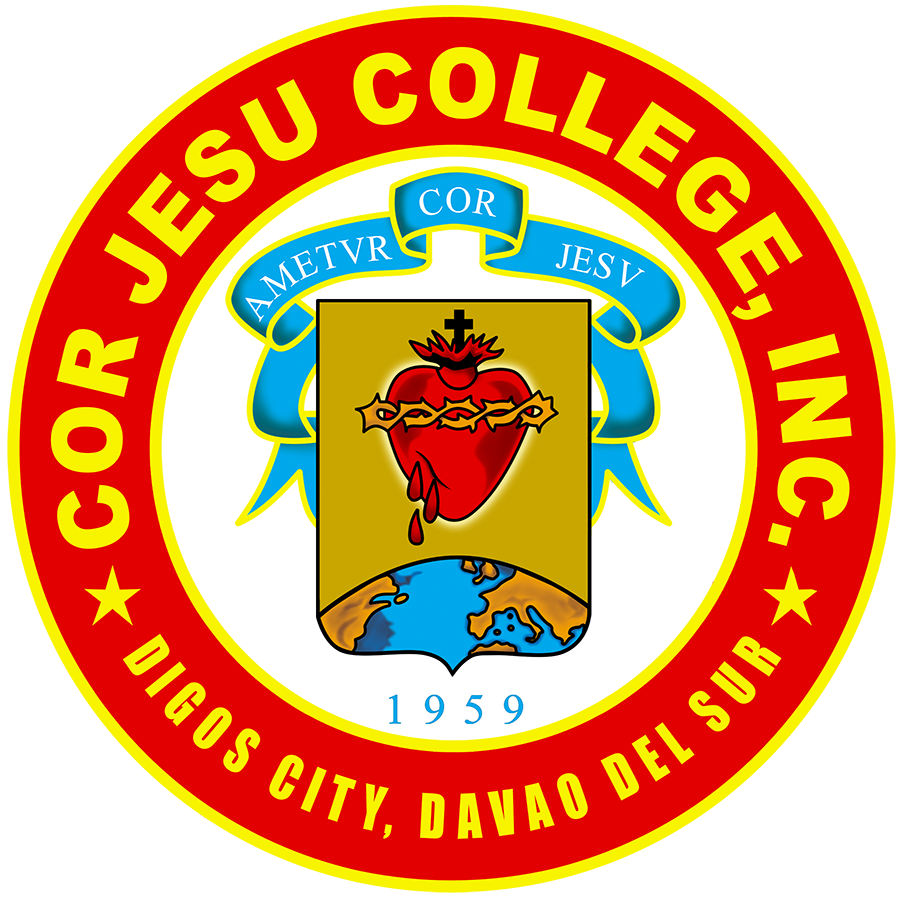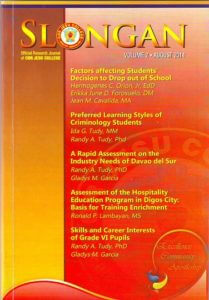Your cart is currently empty!
Slongan Volume 2 Contents
| Factors affecting Students’ Decision to Drop out of School[sdm_download id=”2333″ fancy=”0″] 120 KB Hermogenes C. Orion, Jr, EdD, Erikka June D. Forosuelo, DM and Jean M. Cavalida, MA |
| Abstract Dropping out is a serious problem because it denies individual students their fundamental human right to education. The study aims to find out the reasons why students drop out of school and the factors that contribute to the high dropout rate in order to provide a programme design to identify mode of interventions to address the problem. It is a descriptive-correlational and comparative type of research. Descriptively, results revealed that financial resources were the major reason why students drop out of school. Inferentially, result showed significant differences in terms of policies and practices, student-teacher relationship, financial resources and academic performance except the nature of the curriculum which shows no significant difference by the number of times the students dropped from school year 2010-2011 to school year 2012-2013, while age, civil status and sources of tuition payment are contributory factors that lead students to drop out of school. Keywords: dropout, policies and practices, student-teacher relationship, nature of the school curriculum, financial resources. |
| Preferred Learning Styles of Criminology Students[sdm_download id=”2335″ fancy=”0″] 100 KB Ida G. Tudy, MM and Randy A. Tudy, Phd |
| Abstract Over the past decades, knowledge on the students’ learning styles gained interest among educators. Several studies considered learning styles as predictors to academic performance. This study aimed to investigate on the learning styles of criminology students of Cor Jesu College. It employed descriptive quantitative research design using the instrument developed by Andrew D. Cohen, Rebecca L. Oxford, and Julie C. Chi. Results showed that the respondents were visual, introverted, random-intuitive, closure-oriented, particular, synthesizing, sharpener, deductive, field-independent and reflective. They also considered themselves as both metaphoric and literal. The respondents were also consistent when it came to preferred learning style regardless of sex, except for field-independent for males and field-dependent for females. Hence, it can be argued that the respondents can easily be grouped according to their preferred styles. The result served as a useful feedback to students to maximize their potentials and preferences and for teachers to tailor their teaching strategies in line with the learning styles of the students. On a larger scale, it is important that in the revision of curriculum the school should consider the learning preferences of the students for it to be adaptive, effective and relevant. Keywords: Learning Styles, Criminology, Social Science, Descriptive Study, Philippines |
| A Rapid Assessment on the Industry Needs of Davao del Sur[sdm_download id=”2337″ fancy=”0″] 108 KB Randy A. Tudy, PhD and Gladys M. Garcia |
| Abstract Job mismatch continues to be a problem in many countries and it poses a real challenge to the academe. In the Philippines, the Commission of Higher Education (CHED) imposes a moratorium on selected courses. One of the main reasons of this action is job mismatch. This study aimed to determine the needs of the industries in the province of Davao del Sur. It employed qualitative design using the a Rapid Assessment Process (RAP). Key Informant Interviews (KIIs) of human resource managers or recruitment in-charge of participating companies were conducted. The findings revealed that computer literacy, oral and written communication skills, interpersonal skills, possession of the required industry-specific skills and good character are essential factors the industries look for when hiring a potential employee. These industries also expressed expansion plans which would mean additional manpower in the near future. These identified core skills, except for some industry specific skills, are provided in the curriculum of the schools within the province. Moreover, the implementation of the K to 12 Program, which integrates TESDA competencies, is a welcome development. However, the schools must level up and address the specific needs in order to be relevant and responsive to the needs of the industries. Keywords: Business Management, Industry Needs, Rapid Appraisal Process, Philippines |
| Assessment of the Hospitality Education Program in Digos City: Basis for Training Enrichment[sdm_download id=”2339″ fancy=”0″] 181 KB Ronald P. Lambayan, MS |
| Abstract This study was conducted to assess the hospitality education program of Schools in Digos City to provide a basis for developmental and training interventions. The study utilized descriptive-evaluative research methods and employed universal sampling techniques in respondent selection that included administrators, teachers and students. Data were analyzed using descriptive statistics and one–way ANOVA. The study revealed that implementation of best practices in hospitality education program in Digos City have moderate implementation of best practices. The overall response of the respondents in terms of the extent of implementation of hospitality education program is 3.17 or satisfactory . The Study also concluded that there is significant difference on the level of hospitality education program in the four schools rated in terms of curriculum program, logistics and approaches, teaching pedagogy and linkages and network when grouped according to schools. Keywords: Hotel and Restaurant Management, Hospitality Education, Descriptive-Comparative, Philippines |
| Skills and Career Interests of Grade VI Pupils[sdm_download id=”2341″ fancy=”0″] 118 KB Randy A. Tudy, PhD and Gladys M. Garcia |
| Abstract Unemployment or job-mismatch remains a concern for governments and service providers. This study was geared towards identifying the skills and career interests of Grade VI pupils. It employed a descriptive research design using research-made questionnaires. The participants were from the top seven feeder schools of Cor Jesu College, Digos City, Philippines. Data were analyzed using frequency and percentages. The skills they wanted to develop in high school are computer and IT related skills. The programs students preferred to pursue in college were Business Management, Engineering and Architecture and Computer Science. Licensure examination, facilities and accessibility are factors to influence them to choose a college while employability as a factor in choosing a program. Cor Jesu College, Ateneo de Davao University and University of Mindanao were the top three preferred tertiary institutions. The respondents saw themselves managing their own business or working in a company in the future. After college, they were almost equally divided whether to work abroad or remain in the country. It appeared that the young pupils had inclinations towards computer and allied technology skills which were consistent with their career preference. The result of the study will have a big implication for schools offering K to 12 and college programs. Keywords: Business and Management, Skills and Career, Descriptive Method, Philippines |

